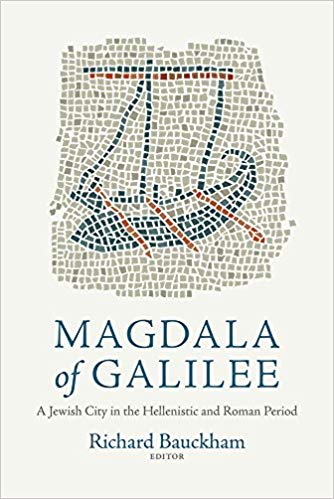Q. WHAT FOR YOU WAS THE MOST EXCITING AND IMPORTANT DISCOVERY AT MAGDALA OF RELEVANCE TO NT STUDIES?
A. In spite of what I have just said bout the fish workshops, I think this has to be the synagogue together with the synagogue stone. When discovered in 2009, the synagogue was the first synagogue from before 70 CE within Galilee to be excavated. (When I say that, people often say: But what about Capernaum? The synagogue you see at Capernaum is of much later date [3rd, 4th or even 5th century.] Archaeologists cannot excavate underneath it, where most likely the first-century synagogue was. They did sink a shaft and discovered that there was an earlier building on the site, but the synagogue Jesus knew has not been excavated. A synagogue from before 70 was excavated at Gamla and the architectural similarities to the building in Magdala help to establish that the latter was a synagogue, but Gamla is in the Golan, not Galilee. It used to be possible to claim that there were no purpose-built synagogues in Galilee in the time of Jesus, simply because none had been found. It is a good example of the fact that no evidence is not the same as evidence against. Since the discovery of the synagogue in Magdala, two smaller synagogues have been found elsewhere in Galilee. It begins to look as though every settlement had a synagogue. But at Magdala, we have also the remarkable carved stone table, a unique object, which tells us probably as much about Galilean synagogues as all of the literary evidence does.
Q. LET’S TALK ABOUT THE SO-CALLED SYNAGOGUE STONE. YOU MAKE AN EXCELLENT CASE FOR CONNECTING THE SYMBOLS ON THE STONE WITH THE TEMPLE IN JERUSALEM, AND PERHAPS EVEN WITH OFFERINGS THAT WOULD BE TAKEN TO THE TEMPLE BY LOCAL PRIESTS OR LEVITES. HOW THEOLOGICALLY AND LITURGICALLY CONNECTED DO YOU THINK THESE GALILEAN SYNAGOGUES WERE WITH THE TEMPLE IN JERUSALEM? WERE THEY HOUSES OF WORSHIP AND NOT JUST HOUSES OF MEETING AND TORAH STUDY?
A. Although there are different interpretations of some of the images engraved on the stone and of the function of the stone, virtually everyone agrees that the imagery is connected with the Jerusalem temple (the Menorah is unmistakable). So at the very least it shows us that people connected what they did in the synagogue with what went on in the Jerusalem temple (to which, of course, many of them went on pilgrimage). None of the (rather meager) literary evidence makes that clear, and so it has been doubted in the past. My own interpretation of the stone – as an offering table on which first fruits from the area’s farms were gathered before being taken to Jerusalem – would probably imply, I guess, some kind of liturgical act of offering the produce to God with a view to the offering on the altar in the Temple. If the stone was visible throughout the year, it would be a visual reminder of the Temple whenever people gathered in the synagogue. That said, I’m not sure how much further we can go in talking about “worship” in synagogue. We know that Torah was read and studied – and the architecture, with people sitting around all four sides of a rectangular space, must have been intended to facilitate interaction and discussion. We have to imagine something really different from our churches, where usually the congregation all face the front. That’s really important. We also know that sometimes individuals would go to the synagogue to say their individual daily prayers (as Josephus did in Tiberias). In the street outside the synagogue in Magdala, there is a large stone basin, which was presumably used for people to wash hands in an act of purification before attending the synagogue. This suggests that the synagogue was a sacred space, not just a communal facility for town meetings. That’s as far as the evidence really takes us. But another aspect of the Magdala synagogue is worth emphasizing: as well as the main hall, there is a quite large room that the excavators called the vestibule. Almost certainly, they were wrong about that and the entrance to the synagogue (which has not been found) did not open into that room. Rather it is what the rabbis called a bet ha-midrash, a “house of study,” where study of Torah could go on in a different way from the general meetings in the main hall. We know almost nothing about the important subject of education in first-century Galilee. This is an important piece of evidence, though we cannot say definitely whether children were instructed there or whether it was reserved for adults who wanted to study halakhah.












